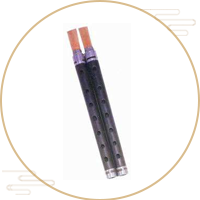Double-pipe rant overview
 Shuangguanjilangtao (pinyin: shuāng guǎn bì lǎng dāo) is a single-reed gas-sounding instrument of the Dai and De'ang ethnic groups. It is popular in Luxi, Ruili, Yingjiang, Zhenkang and Gengma in Lincang, Dehong Dai and Jingpo Autonomous Prefecture, Yunnan Province.
Shuangguanjilangtao (pinyin: shuāng guǎn bì lǎng dāo) is a single-reed gas-sounding instrument of the Dai and De'ang ethnic groups. It is popular in Luxi, Ruili, Yingjiang, Zhenkang and Gengma in Lincang, Dehong Dai and Jingpo Autonomous Prefecture, Yunnan Province.In the Dai language, it is called 筚langtao, and "筚" is the general name of the Dai nationality's chiming musical instruments. The De'ang people call Bulai, "bu" means blowing, "lai" means gourd, which means blowing gourd. Local dialects are also known as Ohgebao and Mirren.
It consists of speakers, sound tubes and reeds. The speaker is mostly made of a waistless whole gourd, the bottom is drilled to remove the grains, and a thin bamboo tube is inserted into the gourd handle for the mouthpiece. The sound tube is made of two bamboo pipes with different thicknesses, the upper end is closed, the middle is transparent, the lower end is open, and the bottom end of the gourd is inserted in parallel. Each sound tube inserted into the gourd cavity is inlaid with a reed. Made of silver alloy, the tongue is engraved on the spring frame, forming a sharp 12° triangle. The sound tube was sealed and fixed with beeswax. The thick and long sound tube is the main tube, the length of the tube is 25 cm to 37 cm, and the diameter of the tube is about 1.5 cm. ; The thin and short auxiliary pipe is only inlaid with reeds, without opening the sound hole, and can only emit a barrel sound, and is equipped with a piston. When the auxiliary pipe is not needed to sound, the auxiliary pipe can be blocked. The pitch and tone sequence of the sound tube vary by ethnic group and region.
After the founding of the People's Republic of my country, Chinese national musicians carried out reforms on the double-pipe rambler. In 1958, the Yunnan Song and Dance Troupe first designed and produced a kind of horn with two supervisors and no assistant pipes on the basis of the traditional horn. more than an octave.
In the 1970s, a double-pipe four-degree horn was successfully developed. A copper gourd-shaped speaker is used instead of a natural gourd. The sound tube is made of plastic. The two tubes are four degrees apart. One sound range is c1-d2, and the other sound range is f1-g2. There are five double-tones in between. Various chords and simple polyphony can be played.
- Chinese name:Double-pipe rant
- nation of origin:Dai and De'ang
- Origin:Yunnan
- Instrument category:clarinet air musical instrument
- pinyin:shuāng guǎn bì lǎng dāo
overview of other similar instruments
- sanyanxiao overview
- Daguangxian overview
- Leiqin overview
- hahao overview
- yandundagu overview
- Han Xiaozheng overview
- Fang Xiang overview
- guanzi overview
- zhuqin (Dao Qin) overview
- zhuiqin overview
- bangzi overview
- three-stringed piano overview
- Gehu overview
- xiao overview
- xiaokonghou overview
- Konghou overview
- Sheng overview
- suona overview
- hulusi overview
- gushao overview
 渝公网安备 50010702504639号
渝公网安备 50010702504639号